 Gilman Studio On-Line Lessons
Gilman Studio On-Line Lessons
Yang Style Long Form
Tai Chi Chuan
This Lesson Contains:
Movement # 37 – Wave Hands Like Clouds
This is one of the most popular and characteristic movements of Tai Chi Chuan. The graceful, flowing roundness of the hands making circles in front of the body is very meditative and relaxing. Most people have no idea it has martial applications. Clouds Hands is repeated three times in the long form and I give each a different application, which slightly affects the structure. Stay tuned.
I am attacked from the left side by a right punch. I join, stick, and lead the energy to the right, closing up and uprooting my opponent. As he tries to retreat, I step behind him with my left foot, and throw him over my leg.
Waving Hands Like Clouds uses a step called Side Step. The movement of the body is to the left and when stepping to this side, we maintain the same orientation of the lower body, that of shoulder width and parallel feet with the knees covering the toes. The turning is done with the torso so be careful not to turn so much from side to side that your knees and hips get pulled out of alignment.
The number of side steps is repeated three times in my form. This number varies according to the teacher. I have seen people do from one to five. It obviously doesn’t matter. In my form, we end up in the same place we started, so the number is important for that reason only.
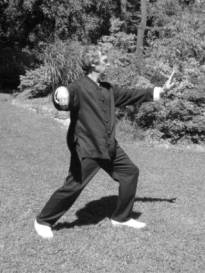
 The movement starts at the end of Single Whip. The opponent is on my left side in a threatening position.
The movement starts at the end of Single Whip. The opponent is on my left side in a threatening position.

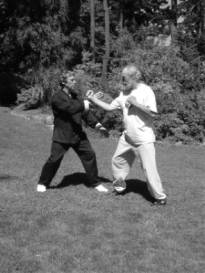 John punches with his right fist to my center. I join with the back of my right wrist.
John punches with his right fist to my center. I join with the back of my right wrist.
There is very little body movement and no foot changes.
The right hand which was previously in a hook, opens and circles down by the right side and then up to the center of the chest with the palm facing to the left. The left hand relaxes and stays in the center of the body.
The right hand is actually thrown up like bowling a ball. The weight sinks more deeply into the left Kua.
Focus on the back of the right wrist to join with opponent’s wrist.
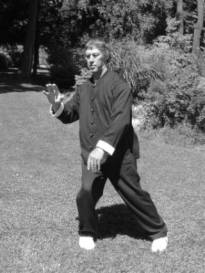
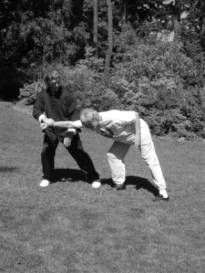 I now lead John’s energy to the right and uproot him. Notice the placement of my left arm. It would be easy to apply an elbow lock by pressing outward with my left forearm against his elbow and pulling inward with my right hand.
I now lead John’s energy to the right and uproot him. Notice the placement of my left arm. It would be easy to apply an elbow lock by pressing outward with my left forearm against his elbow and pulling inward with my right hand.
The weight shifts back onto the right foot, and as you do, the torso turns to face north. When all the weight is on the right foot, turn in the left toe to face north. This is the only repetition of the movement where the left foot is not stepped to the left at this point.
The left arm drops down to the front of the crotch to protect the groin. The right hand moves with the body to the right. It actually is basically in the same place as when I joined with John’s wrist, but the turning of my body brings the hand with it. The palm turns to face down in order to grab.
Focus on the right palm.

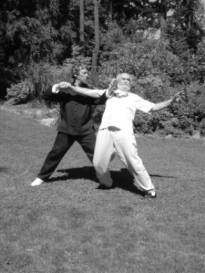 I apply Peng Jing and throw John over my leg. This part of the movement is actually Ward Off Left done to the side.
I apply Peng Jing and throw John over my leg. This part of the movement is actually Ward Off Left done to the side.
Shift the weight onto the left foot, turn the right toe to face north, then bring the right foot back parallel to the left foot and shoulder width.
The right arm is circled downward to end up by the right hip. The left arm is circled upward across the front of the body to end up by the left shoulder. Turning the torso to the left does all this.
Focus on the left forearm for Peng Jing and the right hand for maintaining tension on opponent’s arm.
This is not counted as one repetition, but all the repetitions have the same application, that of join, lead, trap, and attack.
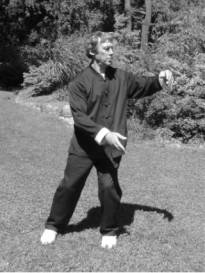
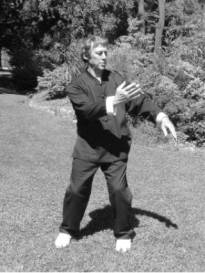 Repetition number one.
Repetition number one.
The right arm starts to circle up to the left in order to intercept opponent’s attack. The left palm turns downward and the arm starts to circle downward.
The weight starts to shift to the right foot and the torso starts to turn to the right.
In the first picture I haven’t yet joined with John’s wrist. In the second, I have joined and start to lead him to the right.
Focus on the right wrist for joining.
Make sure to keep the knees bent all through this movement. It is easy to stand up particularly when passing center. Be sure that the turning of the center moves the arms. Keep the elbows and shoulders drooped and relaxed.

 The weight is fully shifted onto the right foot, activating the Kua. The left foot steps to the left as far as possible without moving off the right root. Do not lean to the right. Keep the left foot parallel and shoulder width. The left leg is straight but not locked. The right hand is turned downward to grab. It is on the right side of the chest. The left arm has circled down and left to end up in front of the crotch. This is the pull and step to trap opponent.
The weight is fully shifted onto the right foot, activating the Kua. The left foot steps to the left as far as possible without moving off the right root. Do not lean to the right. Keep the left foot parallel and shoulder width. The left leg is straight but not locked. The right hand is turned downward to grab. It is on the right side of the chest. The left arm has circled down and left to end up in front of the crotch. This is the pull and step to trap opponent.
I then start to add Peng Jing. The weight starts to shift to the left, and the torso starts to turn to the left. The left arm moves upward and circles to the left. The right is circling to the right and down. I am halfway on the turn to the left and now everything faces north.
The focus is on the right hand for grabbing and then on the left arm for attacking.
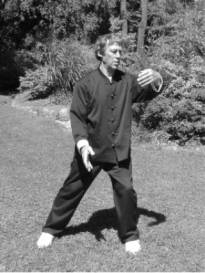 The first repetition is completed. The weight is shifted onto the left foot. The right leg is straight without being locked. The torso faces slightly to the left with the nose pointing to the left knee. The left arm has ended up in front of the left side of the upper chest with the palm facing inward. The right arm ends up in front of the crotch with the palm facing to the left. Be careful not to lean. Focus on the left forearm and the right palm.
The first repetition is completed. The weight is shifted onto the left foot. The right leg is straight without being locked. The torso faces slightly to the left with the nose pointing to the left knee. The left arm has ended up in front of the left side of the upper chest with the palm facing inward. The right arm ends up in front of the crotch with the palm facing to the left. Be careful not to lean. Focus on the left forearm and the right palm.
This is repeated twice more in this sequence:
Lift the right foot and replace it to the left about two foot widths. The right hand circles up to the left side of the chest to join with the incoming energy. Lead the energy to the right (right hand circles to the right while the left hand circles downward. Uproot by pulling (palm turns down and you sink deeper into the right Kua). At the same time, step to the left with the left foot parallel to the right foot in order to block opponent’s retreat. Attack by shifting the weight to the left foot. Turn the torso to bring up the left forearm and circle down the right.
Remember that the torso turns to the right and left, which move the two hands from one side to the other. The hands circle by moving across the body together, the top hand faces inward and the bottom hand faces the direction it is headed. They change places on the sides of the body – one rises while the other drops. Look beyond the hand about two feet, and relax the gaze.
